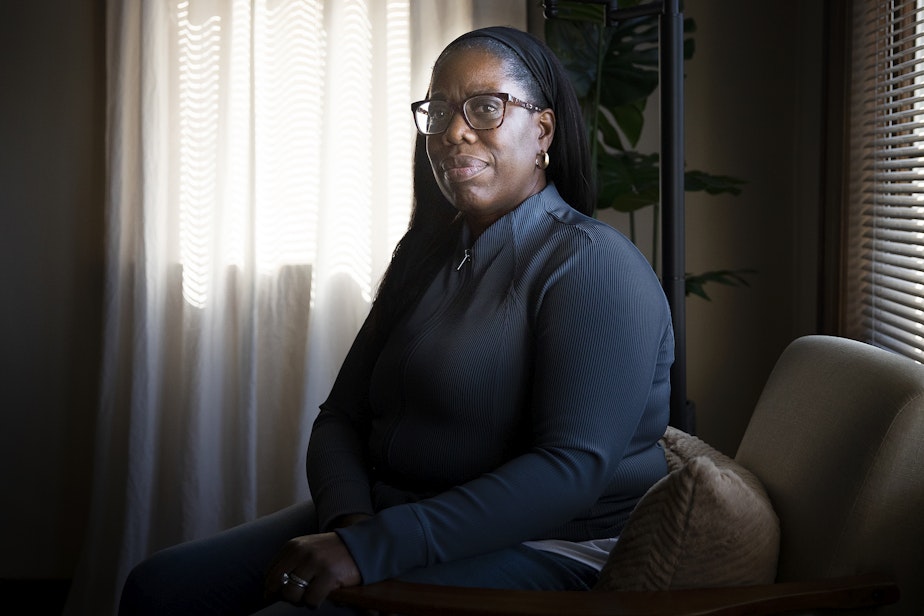Highway robbery: What keeps Seattle-area women in the salary slow lane

Early in her career, Chanin Kelly-Rae, a diversity and inclusion consultant in Seattle, experienced what is sometimes called “the breadwinner bonus.”
She worked at a law firm where one of the named partners told her she couldn’t have the same pay as the white guy she worked alongside, “because he had a family and kids that he had to support.”
It’s been 60 years since the signing of the Equal Pay Act, which forbids employers from paying women less than men for equal work. But decades later, women still don’t make as much as men. And Washington state has one of the widest gaps in median earnings in the country.
Full-time working men in Washington state earn a median salary $14,600 more than women, according to Census data. That’s the fifth-largest gap across all 50 states and the District of Columbia.
It’s not as simple as men and women being paid dramatically different salaries for equal jobs. The gender pay gap in Washington has more to do with the types of jobs men and women pursue. That doesn’t mean bias and discrimination don’t exist. But they play a more subtle role influencing the decisions men and women make, which can be difficult to capture in the data.

Sponsored
One cause of the gender pay gap is the over-representation of men in tech – a dominant industry in Washington. Tech jobs tend to pay well, especially in leadership roles. Women are a minority in both. At Microsoft and Amazon women make up about 33% of corporate workers.
Plus, with tech workers’ long hours, it can be difficult for their partners to take on equally demanding jobs. That’s especially true for families with children.
By contrast, women are over-represented in lower-paying fields, like caregiving. The most common job for women in Washington state is registered nurse, which pays a median salary of about $77,000 – roughly half of the top job for men, software engineers. There is also a large gap in earnings between men and women who code. Male software engineers earn a median salary of about $150,000, while women make $93,000, Census data shows.
Sonia Dillane is a senior software engineer living in Seattle. She studied physics and went on to work for Amazon. She compared that journey to a highway -- with lots of off-ramps.
Those first off-ramps come in the form of subtle discrimination women face in their education and early careers. Dillane remembers more women in her classes as a freshman in college.
Sponsored
“By senior year, a lot of them had left,” she said. “You’re told you don’t belong here over and over again. And there’s only so long you can take that.”
Then comes the biggest off-ramp of them all: becoming a mother.
RELATED: How to lose money if you’re a working woman? Have kids
Studies show that men’s salaries go up when they become fathers, while mothers’ earnings often never recover.
In one study, mothers who took just one year off earned annual salaries 39% lower than their peers when they returned to work.
Sponsored
Kelly-Rae, the diversity consultant, was aware of that reality when she and her husband were deciding who would take a career break to care for their kids. They decided her husband would step back from his management career. She said it was easier for him to bounce back as a white man.
“If I had taken two or three or four years off, or any amount of time off, and then pivoted to come back into the workforce, people would have looked at that time off, and I would have had a lot of explaining to do,” she said.
Those experiences provide a window into why the gender pay gap persists.
Patty Murray, the U.S. senator from Washington state, is a vocal advocate for equal pay.
“We do have a lot of high-tech, high paid men in that industry,” Murray said. “One of the things we should be doing is really encouraging more women to go into these high-tech jobs.”
Why there are so few women in tech
Sponsored
Tech companies have tried to diversify in recent years, but with limited success.
About 30% of jobs at America’s biggest tech companies are held by women. Those numbers drop lower for leadership roles. Tech companies have tried to change that by hiring diversity leaders like Kelly-Rae. Amazon brought her on as a global manager for diversity in 2019.
She said she was hired at a lower level – and salary -- than initially promised. She resigned less than a year later.
“I decided that I knew my own worth and then I decided to separate,” Kelly-Rae said.
Amazon pointed to progress in its diversity efforts in response to Kelly-Rae's comments.
Sponsored
Kelly-Rae said tech companies could do a better job diversifying if they approached it like other difficult problems they’re known to solve.
That would require bringing more women into tech in the first place and ensuring they don’t get pushed out.

Linda Conway, a senior project manager at a semiconductor startup in Redmond, is used to being the only woman in the room.
“I still routinely get shocked at how little men can think of me,” she said.
Until recently, Conway and a colleague were the only two women on their 30-person engineering team. They recently hired a third woman.
Conway said she feels valued in her current role.
But she suspects she was paid less than her male colleagues in previous jobs.
“The reason I have this hunch is also because I saw myself getting passed for different opportunities and not getting promoted as fast as maybe other people around me,” she said.
This is one way bias can hide in the data.
The gender pay gap in tech virtually disappears when you adjust for job title.
But that doesn’t reflect the lost earnings of women who aren’t promoted to the same title as their male colleagues.




